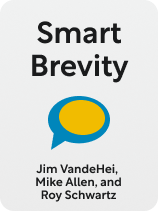

This article is an excerpt from the Shortform book guide to "Smart Brevity" by Jim VandeHei, Mike Allen, and Roy Schwartz. Shortform has the world's best summaries and analyses of books you should be reading.
Like this article? Sign up for a free trial here.
Are you struggling to make an impact on social media? Do you want to learn how to write social media posts that grab attention and deliver your message effectively?
In Smart Brevity, authors Jim VandeHei, Mike Allen, and Roy Schwartz provide insightful tips on crafting compelling social media content. They emphasize the importance of brevity, clarity, and visual appeal in capturing your audience’s attention in today’s fast-paced digital landscape.
Read on to discover expert tips on how to write social media posts that stand out and engage your followers across various platforms.
Writing Social Media Posts
It can be argued that the changes in how people consume information—the very impetus for this book—are primarily due to social media platforms. VandeHei, Allen, and Schwartz explain that social media—an environment characterized by short attention spans and information overload—demands brevity and clarity if you want to be heard. The authors provide tips on how to write social media posts by leveraging their principles, such as how to catch your readers’ attention, how to design attractive visual elements, and how to target your messaging for different social media platforms.
Social media feeds are cluttered and fast-moving. Instead of expecting social media users to click on a link right away, give your audience something valuable upfront—an idea, a joke, or a piece of information. This can take the form of a provocative quote, a surprising factoid, or a flashy bit of news to pique the reader’s curiosity. The authors assert that since social platforms limit how much content they show on each post, you have to strip your message to its most essential elements, conveying your core idea quickly while still making an impact. This equates to the principle of the “six-word strong opening.”
(Shortform note: Social media is nonstop and pervasive, but there’s more to getting your message across than crafting the perfect post. In Jab, Jab, Jab, Right Hook, Gary Vaynerchuk describes how to cut through social media’s noise to connect with an audience. He begins with the same principles of sharp, punchy writing that the authors of Smart Brevity promote, but he also includes other kernels of advice, such as not interrupting your readers’ online experience, taking advantage of pop culture references, and staying true to your brand identity. Social media presents a lot of communication opportunities not found in other modes of communication, but you must be mindful to use them wisely so as not to waste your readers’ time or your own.)
Since social media is a highly visual medium, the authors emphasize that you should choose clear, straightforward, and captivating images to complement your text. When designing charts, graphs, and illustrations, focus on highlighting the most important elements of the image. You can use tricks of perspective and color to assign importance to different parts of each graphic, and edit out any distracting components. Evaluate the visual from the audience’s point of view to ensure that your concept is easily understood and that all of its components communicate what you intend. Make sure to pair your pictures with strong, direct language to quickly capture the viewer’s attention and convey your message.
(Shortform note: You might find image design challenging if you don’t have a background in the visual arts. Thankfully, you don’t have to start from scratch. In Steal Like an Artist, Austin Kleon argues that it’s perfectly all right to learn the basics of visual design by copying the work of those who came before. Imitating others helps you learn how the original creator of any given image did it. At first, your work will inevitably fall short, but the ways that your copies differ from the original are what make yours unique and stand out. Besides, when following Smart Brevity’s rules, what matters is that you get your message across, not that your approach is completely original. Just be careful not to veer so close to someone else’s work that you violate copyright.)
VandeHei, Allen, and Schwartz point out that different social networks have different content consumption patterns, so you should tailor your approach based on the platform. Twitter (now X) favors urgent news and data, whereas Instagram leans toward striking visuals. Facebook promotes images and ideas that are likely to spark an emotional response, so bland posts are easily lost in its news feed. Across all platforms, clear and direct visuals and text are essential to catching people’s attention as they scroll.
(Shortform note: When tailoring your messaging for social media, you need to keep in mind how social media platforms evolve. For instance, you can leverage visual storytelling through platforms like Instagram and TikTok to reach younger audiences, incorporating short-form videos into your content mix. You might also explore social media e-commerce to sell products directly through social media platforms. You’ll need to adapt to social media algorithm changes to create content that remains visible. Change in the social media landscape is so constant that you’ll have to reevaluate your approach on a fairly regular basis.)

———End of Preview———
Like what you just read? Read the rest of the world's best book summary and analysis of Jim VandeHei, Mike Allen, and Roy Schwartz's "Smart Brevity" at Shortform.
Here's what you'll find in our full Smart Brevity summary:
- How to cut straight to the point to make content engaging
- How clear communication can strengthen your organization
- Why technology has made long-form writing uninteresting






